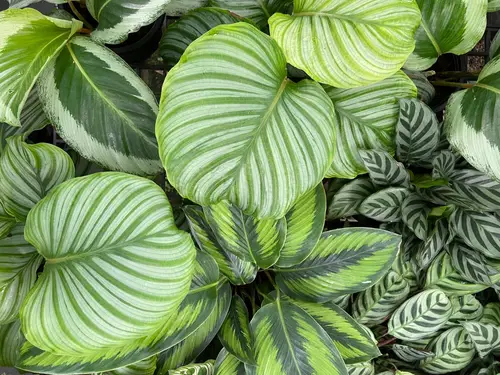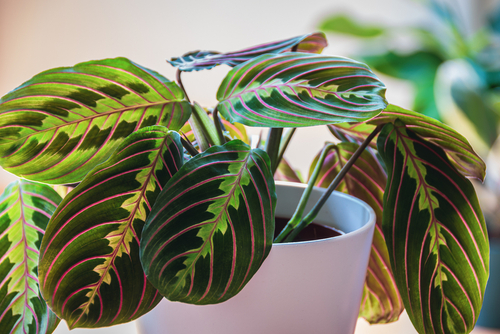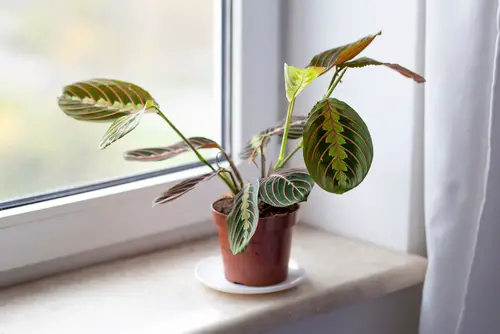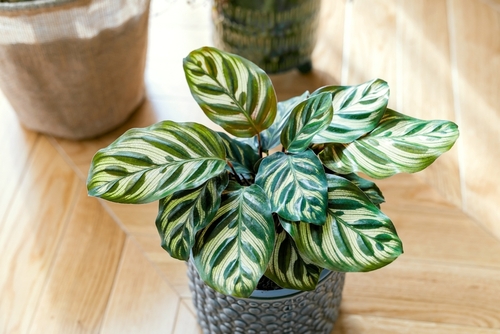White spots on prayer plant leaves can be a cause for concern for many plant owners. These spots can appear suddenly and spread quickly, leading to damage and discoloration of the plant’s leaves. Understanding the causes of white spots on prayer plant leaves is crucial to ensure that the plant remains healthy and vibrant.
Prayer plants, also known as Maranta leuconeura, are popular houseplants known for their striking foliage and unique patterns. They are relatively easy to care for and can thrive in a variety of indoor environments.
However, like all plants, they are susceptible to a range of issues that can impact their health and appearance. One of the most common issues that prayer plant owners face is the appearance of white spots on their leaves.
Identifying the causes of white spots on prayer plant leaves is the first step in treating and preventing the issue. While there are several potential causes, including pests, fungal infections, and environmental factors, proper care and attention can help prevent and address this issue.
In this article, we will explore the common causes of white spots on prayer plant leaves, as well as symptoms and treatment options.
Key Takeaways
- White spots on prayer plant leaves can be a cause for concern for plant owners.
- Understanding the causes of white spots is crucial to ensure the plant remains healthy.
- Proper care and attention can help prevent and address the issue.
Also read:
Understanding Prayer Plants

Prayer plants, also known as Maranta leuconeura, are popular indoor plants known for their striking foliage and unique behavior. These plants are native to the tropical forests of Brazil and are named for their habit of folding their leaves upwards at night, as if in prayer.
Prayer plants are relatively easy to care for and can thrive in a variety of indoor settings. They prefer bright, indirect light and well-draining soil. They also require consistent moisture, but it’s important not to overwater them as this can lead to root rot.
One of the most common issues that prayer plant owners face is the appearance of white spots on the leaves. These spots can be a sign of a variety of different problems, including pests, diseases, and environmental factors.
If the white spots are accompanied by yellowing or wilting leaves, it may be a sign of overwatering or poor drainage. In this case, it’s important to adjust the watering schedule and ensure that the soil is well-draining.
On the other hand, if the white spots are raised and fuzzy, it may be a sign of a fungal or bacterial infection. In this case, it’s important to remove any affected leaves and treat the plant with a fungicide or bactericide.
Finally, if the white spots are small and powdery, it may be a sign of a pest infestation, such as spider mites or mealybugs. In this case, it’s important to isolate the plant and treat it with an appropriate insecticide.
Identifying White Spots on Prayer Plant Leaves
Prayer plants are known for their vibrant foliage and unique colors, but they are also prone to issues that can show up in their leaves. One of the most common issues is the appearance of white spots on the leaves.
These spots can be caused by a variety of factors, and it is important to identify the underlying cause in order to address the issue effectively.
White spots on prayer plant leaves can take on different forms, and it is important to pay attention to the specific characteristics of the spots. Some white spots may appear as small, circular dots, while others may take on a more powdery appearance.
In some cases, the white spots may be accompanied by other symptoms, such as wilting or discoloration.
One possible cause of white spots on prayer plant leaves is a fungal infection. Fungal infections can cause white powdery spots to appear on the leaves, and may also cause the leaves to become distorted or discolored. In some cases, the fungal infection may spread to other parts of the plant, causing further damage.
Another possible cause of white spots on prayer plant leaves is pest infestation. Certain pests, such as spider mites or mealybugs, can cause white spots to appear on the leaves as they feed on the plant. In addition to white spots, pest infestations may also cause other symptoms, such as yellowing or wilting of the leaves.
Finally, white spots on prayer plant leaves may also be caused by environmental factors, such as exposure to cold temperatures or low humidity. In these cases, the white spots may be a sign of stress on the plant, rather than a specific disease or pest infestation.
In order to accurately identify the cause of white spots on prayer plant leaves, it is important to carefully examine the plant and consider any other symptoms that may be present. Once the underlying cause has been identified, appropriate steps can be taken to address the issue and promote the health of the plant.
White Spots on Prayer Plant Leaves – 4 Common Problems

Prayer plants are popular houseplants known for their unique foliage that folds up like hands in prayer. However, these beautiful plants can sometimes develop white spots on their leaves, which can be a sign of an underlying issue. Here are some common causes of white spots on prayer plant leaves:
1. Pests and Infestations
Mealybugs and spider mites are common pests that can infest prayer plants and cause white spots on the leaves. Mealybugs are small, white insects that feed on the sap of plants and leave behind a white, powdery residue.
Spider mites, on the other hand, are tiny, spider-like insects that also feed on plant sap and can cause white spots on the leaves. Regularly inspecting your plants for signs of pests and infestations and treating them promptly can help prevent white spots from developing.
2. Fungal Diseases
Fungal diseases such as powdery mildew can cause white spots on prayer plant leaves. Powdery mildew is a fungal infection that appears as a white, powdery substance on the leaves and stems of plants.
Fungal diseases can be caused by overwatering, poor air circulation, and high humidity levels. To prevent fungal diseases, make sure your prayer plant is in a well-ventilated area with good air circulation, and avoid overwatering.
3. Watering Issues
Watering issues can also cause white spots on prayer plant leaves. Overwatering can lead to root rot and other fungal infections, while underwatering can cause the leaves to dry out and develop white spots.
To prevent watering issues, make sure your prayer plant is in a pot with good drainage and water it only when the top inch of soil is dry.
4. Environmental Factors
Environmental factors such as low humidity, high temperatures, and changes in temperature can also cause white spots on prayer plant leaves. Prayer plants prefer high humidity levels and temperatures between 60 and 80 degrees Fahrenheit.
If the air in your home is too dry, consider using a humidifier to increase humidity levels around your plant. Additionally, avoid placing your prayer plant near air conditioning vents or drafty windows, which can cause temperature changes and stress the plant.
Symptoms and Damage
Prayer plants are known for their beautiful foliage, but white spots on their leaves can indicate underlying issues. These spots can be alarming, but understanding the symptoms and damage caused by them can help plant owners take appropriate action.
Leaf Changes

White spots on prayer plant leaves can appear in different forms, such as powdery patches or raised bumps. These spots can be caused by a variety of factors, including fungal diseases, pests, and poor water quality.
In some cases, the spots may be accompanied by other leaf changes, such as yellowing or browning of the affected leaves.
Yellowing leaves can indicate a watering issue, such as overwatering or underwatering. Overwatering can lead to root rot, which can cause the leaves to turn brown and the stem to become soft. Underwatering, on the other hand, can cause the leaves to wilt and droop.
Plant Behavior
White spots on prayer plant leaves can also affect the plant’s behavior. For instance, if the spots are caused by a fungal disease, the plant may become weak and stunted. Pests, such as spider mites or mealybugs, can also cause damage to the plant, leading to droopy leaves and reduced growth.
It is important to identify the cause of the white spots and take appropriate action to prevent further damage. This may involve adjusting watering habits, applying fungicides or pesticides, or repotting the plant in fresh soil.
Treatment and Care for Affected Prayer Plants
If your prayer plant leaves have white spots, it is essential to take immediate action to prevent further damage. Here are some effective treatment and care tips that can help you restore the health of your affected prayer plants.
1. Pest Control
White spots on prayer plant leaves can be caused by pests such as spider mites, mealybugs, and scale insects. To control these pests, you can use neem oil, insecticidal soap, or horticultural oils.
These products can be applied using a spray bottle, making sure to cover both the top and bottom of the leaves. It is recommended to repeat the treatment every 7-10 days until the pests are eliminated.
2. Fungal Disease Management
If the white spots on your prayer plant leaves are caused by a fungal disease, you can use a fungicide to control the problem. Fungicides are available in different forms, including liquid, powder, and granules.
It is essential to read the label instructions carefully before applying the product and wear protective gear, such as gloves and a mask. Some effective fungicides include sulfur and baking soda.
3. Watering and Humidity Adjustment

Proper watering and humidity levels are essential for the health of prayer plants. Overwatering or underwatering can cause stress to the plant and make it more susceptible to diseases and pests.
It is recommended to water prayer plants thoroughly once a week, allowing the soil to dry out slightly between watering. Bottom watering is also an effective method to ensure the entire soil mass is moistened.
Prayer plants prefer high humidity levels, and a humidifier can be used to maintain the ideal humidity level of 50-60%. Alternatively, you can place a tray of water near the plant or mist the leaves with water using a spray bottle.
4. Environmental Adjustments
Prayer plants thrive in indirect light and temperatures between 65-75°F. Direct sunlight can scorch the leaves and cause stress to the plant. If your plant is exposed to direct sunlight, move it to a location with filtered light.
It is also essential to ensure your prayer plant is planted in well-draining soil and a pot with drainage holes. This will prevent water from accumulating at the bottom of the pot and causing root rot.
Prevention Strategies
Preventing white spots on prayer plant leaves requires proper care and maintenance. Here are some strategies to help keep your prayer plant healthy and spot-free.
1. Watering
Overwatering can lead to white spots on prayer plant leaves, so it’s important to water them properly. Make sure the soil is moist but not waterlogged, and allow the top inch of soil to dry out before watering again. Using a moisture meter or a finger to check the soil’s moisture level can help prevent overwatering.
2. Light
Prayer plants prefer bright, indirect light. Too much direct sunlight can scorch the leaves and cause white spots to appear. Place your prayer plant near a window with filtered light or use a sheer curtain to diffuse the light.
3. Humidity
Prayer plants thrive in high humidity environments. Using a humidifier or placing a tray of water near the plant can help increase humidity levels. A hygrometer can also be used to monitor humidity levels and ensure they are within the optimal range of 40-60%.
4. Soil

Prayer plants prefer well-draining, nutrient-rich soil. Using a high-quality potting mix or adding organic matter to the soil can help provide the necessary nutrients. Ensuring proper drainage is also important to prevent water from sitting in the soil, which can lead to root rot and white spots on the leaves.
5. Pests and Fungus
Pests and fungus can also cause white spots on prayer plant leaves. Regularly inspecting the plant for signs of infestation and promptly treating any issues can help prevent the spread of pests and fungus. Using natural pest control methods and avoiding over-fertilization can also help prevent infestations.
6. Greenhouse
If growing prayer plants in a greenhouse, it’s important to maintain proper ventilation and avoid overcrowding. This can help prevent the spread of pests and fungus and ensure the plants have enough space to grow and thrive.
7. Cleaning and Quarantine
Regularly cleaning the leaves of your prayer plant can help prevent the buildup of dust and debris, which can attract pests and fungus. Quarantining new plants before introducing them to your prayer plant collection can also help prevent the spread of pests and diseases.
When to Seek Professional Help
In most cases, white spots on prayer plant leaves can be treated at home with proper care and attention. However, there are times when it may be necessary to seek professional help to prevent further damage to the plant.
If the white spots are accompanied by other symptoms such as wilting, yellowing, or curling of leaves, it may indicate a more serious issue such as a disease or pest infestation. In such cases, it is recommended to consult a professional gardener or plant specialist for proper diagnosis and treatment.
Additionally, if the plant has been exposed to extreme temperatures, drought, or other environmental factors that may have caused damage to the roots, it may be necessary to seek professional help to prevent root rot or other issues from developing.
If the white spots are due to a nutrient deficiency, it is important to determine the specific nutrient that is lacking and provide the plant with the necessary supplements. A professional gardener or plant specialist can help to identify the nutrient deficiency and recommend the appropriate supplements.
In the case of an outbreak of pests or diseases, it may be necessary to seek professional help to prevent the spread of the issue to other plants in the area. A professional can provide guidance on proper treatment and prevention methods.
Impact on Humans and Pets

White spots on Prayer Plant leaves can be concerning for pet owners and parents alike. Fortunately, these spots are generally not harmful to either humans or pets. However, it is important to note that some people and animals may be more sensitive or vulnerable to the plant’s effects.
Prayer Plants are not toxic to humans or pets. All varieties of the plant are safe, so there is no need to worry about any adverse effects from exposure to the plant.
That said, it is still a good idea to keep pets away from the plant, as they may damage it severely. Some pets may be attracted to the plant’s leaves and may even try to eat them. This can cause damage to the plant and potentially harm the animal.
It is also worth noting that some people may be more sensitive to the plant’s effects than others. Prayer Plants are prone to issues that show up in their foliage, such as discolored leaves, wilting, or spots.
Since the plant has delicate leaves, these problems can appear even more severe than they might be in more hearty plants. People who are sensitive to these issues may experience discomfort or irritation if they come into contact with the plant’s leaves.
Conclusion
White spots on prayer plant leaves can be caused by a variety of factors, including pests, diseases, and environmental factors. It is important to identify the underlying cause of the white spots to effectively treat the issue and prevent it from recurring.
One common cause of white spots on prayer plant leaves is powdery mildew. This fungal disease can be identified by the presence of white, powdery spots on the leaves. To treat powdery mildew, it is important to remove infected leaves and improve air circulation around the plant. Fungicides can also be used to control the disease.
Another possible cause of white spots on prayer plant leaves is spider mites. These tiny pests can cause white or yellow spots on the leaves, as well as webbing and leaf drop. To control spider mites, it is important to regularly inspect the plant for signs of infestation and use insecticidal soap or neem oil to control the pests.
Environmental factors, such as low humidity or water quality issues, can also cause white spots on prayer plant leaves. To prevent these issues, it is important to maintain a consistent watering schedule and provide adequate humidity for the plant. Using distilled or filtered water can also help prevent water quality issues.
Frequently Asked Questions
How to treat white spots on prayer plant leaves?
To treat white spots on prayer plant leaves, it is important to first identify the underlying cause. White spots can be caused by pests, diseases, or even poor environmental conditions.
Once the cause is identified, the appropriate treatment can be administered. This may include pruning affected leaves, applying insecticidal soap or neem oil, or adjusting the plant’s watering and lighting conditions.
What causes tiny white spots on prayer plant leaves?
Tiny white spots on prayer plant leaves are often caused by pests such as spider mites or mealybugs. These pests feed on the plant’s sap, leaving behind white spots or speckling on the leaves. It is important to identify and treat the pests promptly to prevent further damage to the plant.
How to get rid of white stuff on prayer plant leaves?
To get rid of white stuff on prayer plant leaves, the underlying cause must be addressed. If the white stuff is caused by pests, applying insecticidal soap or neem oil can help eliminate them.
If the white stuff is caused by powdery mildew, a fungal disease, applying a fungicide or increasing air circulation around the plant can help control the issue.
Why are my prayer plant leaves curling and turning brown?
Curling and browning of prayer plant leaves can be caused by a variety of factors, including overwatering, underwatering, low humidity, or exposure to direct sunlight. It is important to identify the underlying cause and adjust the plant’s care accordingly to prevent further damage.
What are some common signs of an unhealthy prayer plant?
Common signs of an unhealthy prayer plant include yellowing or browning leaves, wilting or drooping foliage, stunted growth, and pest infestations. It is important to monitor the plant’s health regularly and address any issues promptly to prevent further damage.
What are the best ways to prevent white spots on indoor plant leaves?
To prevent white spots on indoor plant leaves, it is important to maintain a healthy growing environment. This includes providing appropriate lighting, watering, and humidity levels, as well as monitoring the plant for signs of pests or diseases.
Regularly inspecting the plant and addressing any issues promptly can help prevent the development of white spots on the leaves.

Hey, I’m Lisa and I’ve been an avid gardener for over 30 years. I love writing, talking and living in the garden! Feel free to connect with me on my socials below


